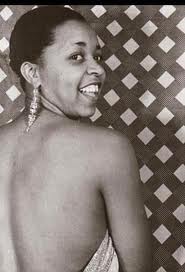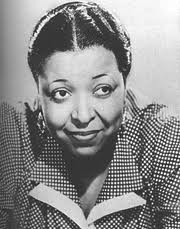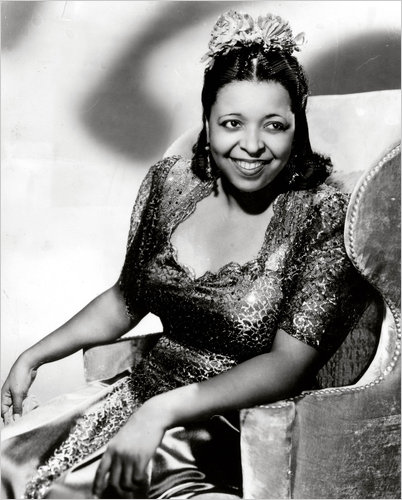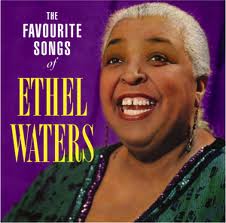Ethel Waters: October 31, 1896-September 1, 1977
Ethel Waters (October 31, 1896-September 1, 1977) was an American blues, jazz, and gospel music vocalist and actress.
She frequently performed jazz, big band, and pop music, on the Broadway theatre stage and in concerts, although she began her career in the 1920s singing blues. Her best-known recording was her version of the spiritual "His Eye is on the Sparrow", and she was the second African American to be nominated for an Academy Award.
Early life
Ethel Waters was born in Chester, Pennsylvania on October 31, 1896, as a result of her mother's rape at age 13.[1]
Ethel Waters was raised in a violent, impoverished home. She never lived in the same place for more than 15 months. She said of her difficult childhood, "I never was a child. I never was cuddled, or liked, or understood by my family." Despite this unpromising start, Waters demonstrated early the love of language that so distinguishes her work. Moreover, according to women-in-jazz historian and archivist Rosetta Reitz, Waters' birth in the North and her peripatetic life exposed her to many cultures. For the rest of her life, this lent to her interpretation of southern blues a unique sensibility that pulled in eclectic influences from across American music.
Waters married at the age of 13, but soon left her abusive husband and became a maid in a Philadelphia hotel working for $4.75 per week. On Halloween night in 1913, she attended a party in costume at a nightclub on Juniper Street. She was persuaded to sing two songs, and impressed the audience so much that she was offered professional work at the Lincoln Theatre in Baltimore, Maryland. She later recalled that she earned the rich sum of ten dollars a week, but her managers cheated her out of the tips her admirers threw on the stage.
Career
After her start in Baltimore, Waters toured on the black vaudeville circuit. As she described it later, "I used to work from nine until unconscious."[2]
Despite her early success, she fell on hard times and joined a carnival, traveling in freight cars along the carnival circuit, eventually reaching Chicago, Illinois]. Waters enjoyed her time with the carnival and recalled, "the roustabouts and the concessionaires were the kind of people I'd grown up with, rough, tough, full of larceny towards strangers, but sentimental and loyal to their friends and co-workers." She did not last long with them, though, and soon headed south to Atlanta, Georgia. There, she worked in the same club with Bessie Smith, who demanded that Waters not compete in singing blues opposite her. Waters conceded to the veteran blues headliner and instead sang ballads and popular songs, and danced.
Perhaps today best known for her blues voice, Waters then was to sing, dance, play and star in musicals, plays and movies, and later in TV; but, she returned to singing blues whenever opportunity presented.
Waters loved a drug addict during this early period, but she ended the destructive relationship sometime before World War I. Around 1919, she moved to Harlem, in New York City, and there became a celebrity performer in the Harlem Renaissance during the 1920s.
Waters obtained her first Harlem job at Edmond's Cellar, a club that had a black patronage. She specialized in popular ballads and became an actress in a blackface comedy called Hello 1919. The jazz historian Rosetta Reitz points out that by the time Waters returned to Harlem in 1921, women blues singers were among the most powerful entertainers in the country.
In 1921, Waters became the fifth black woman to make a record, on the tiny Cardinal Records label. She later joined Black Swan Records, where Fletcher Henderson was her accompanist. Waters later commented that Henderson tended to perform in a more classical style than she would prefer, often lacking "the damn-it-to-hell bass." According to Waters, she influenced Henderson to practice in a "real jazz" style.
She recorded with Black Swan from 1921 through 1923. In early 1924, Paramount Records bought the Black Swan label, and she stayed with Paramount through 1924. Waters then first recorded for Columbia Records in 1925, achieving a hit with her voicing of the song "Dinah"—which was voted a Grammy Hall of Fame Award in 1998.
Soon after, she started working with Pearl Wright, and together they toured in the South.
In 1924, Waters played at the Plantation Club on Broadway, in New York City. She also toured with the Black Swan Dance Masters. With Earl Dancer, she joined what was called the "white time" Keith Circuit, a traditional white-audience vaudeville circuit combined with screenings of silent movies. They received rave reviews in Chicago and earned the unheard of salary of $1,250 in 1928. In 1929, Harry Akst helped Wright and Waters compose a version of "Am I Blue?," her signature tune.
Although she was considered a blues singer during the pre-1925 period, Waters belonged to the Vaudeville-style style similar to Mamie Smith, Viola McCoy, and Lucille Hegamin. While with Columbia, she introduced many popular standards including "Dinah", "Heebie Jeebies", "Sweet Georgia Brown", "Someday, Sweetheart", "Am I Blue?" and "(What Did I Do To Be So) Black and Blue".
During the 1920s, Waters performed and was recorded with the ensembles of Will Marion Cook and Lovie Austin. As her career continued, she evolved toward being a blues and Broadway theater singer, performing with artists such as Duke Ellington.
She remained with Columbia through 1931. She then signed with Brunswick in 1932 and remained until 1933 when she went back to Columbia. She signed with Decca in late 1934 for only two sessions, as well as a single session in early 1938. She recorded for the specialty label "Liberty Music Shops" in 1935 and again in 1940. Between 1938 and 1939, she recorded for Bluebird.
In 1933, Waters made a satirical all-black film entitled Rufus Jones for President, which featured then-child performer Sammy Davis Jr. as Rufus Jones.
She went on to star at the Cotton Club, where, according to her autobiography, she "sang 'Stormy Weather' from the depths of the private hell in which I was being crushed and suffocated."
She took a role in the Broadway musical revue As Thousands Cheer in 1933, where she was the first black woman in an otherwise white show.
She had three gigs at this point; in addition to the show, she starred in a national radio program and continued to work in nightclubs. She was the highest paid performer on Broadway at that time.
MGM hired Lena Horne as the ingenue in the all-Black musical Cabin in the Sky, and Waters starred as Petunia in 1942, reprising her stage role of 1940. The film, directed by Vincente Minnelli, was a success, but Waters, offended by the adulation accorded Horne and feeling her age, went into something of a decline.
She began to work with Fletcher Henderson again in the late 1940s. She was nominated for a Best Supporting Actress Academy Award]] in 1949 for the film Pinky.
In 1950, she won the New York Drama Critics Award for her performance opposite Julie Harris in the play The Member of the Wedding. Waters and Harris repeated their roles in the 1952 film version of Member of the Wedding''
In 1950, Waters starred in the television series Beulah but quit after complaining that the scripts' portrayal of African-Americans was "degrading."
She later guest starred in 1957 and 1959 on NBC's The Ford Show, Starring Tennessee Ernie Ford. In the 1957 episode, she sang "Cabin in the Sky."[3]
Despite these successes, her brilliant career was fading. She lost tens of thousands in jewelry and cash in a robbery, and the Internal Revenue Service hounded her. Her health suffered, and she worked only sporadically in following years.
In 1950-51 she wrote the autobiography His Eye is on the Sparrow, with Charles Samuels. (It later was adapted for a stage production in which she was portrayed by Ernestine Jackson.) In it, she talks candidly about her life. She also explains why her age has often been misstated, saying that her mother had to sign a paper saying she was four years older than she was. She states she was born in 1900. In her second autobiography, To Me, It's Wonderful, Waters states that she was born in 1896.[4]
Rosetta Reitz called Waters "a natural". Her "songs are enriching, nourishing. You will want to play them over and over again, idling in their warmth and swing. Though many of them are more than 50 years old, the music and the feeling are still there."
Private life
In The New York Times Book Review, in a comment on Heat Wave: The Life and Career of Ethel Waters by Donald Bogle[5], David Hajdu says:
- Waters was sexually venturesome, apparently, and she probably had same-sex partners on and off throughout her life, Bogle suggests. He handles this dimension of Waters’s life matter-of-factly, much to his credit. Bogle makes no misguided effort to reposition Waters as an unsung hero of transgressive sexual identity. After all, sexual fluidity was so common among the early blues queens that it was scarcely transgressive in their sphere; it was practically the norm.
In the online encyclopedia GLBTQ.com, Tina Gianoulis writes:
- like many other women blues singers of the day, such as Bessie Smith, Ma Rainey, and Alberta Hunter, she was known to have sexual relationships with other women.
- Although she was not as open as Rainey about her same-sex relationships, Waters had at least one quite public affair with a dancer named Ethel Williams, with whom she flirted from the stage and had notorious lovers' spats. She is also rumored to have had a brief liaison with British novelist Radclyffe Hall, whom she mentions in her autobiography.
Waters is the great-aunt of singer and songwriter Crystal Waters. In the period before her death in Los Angeles, California, she toured with The Reverend Billy Graham, despite the fact that she had once been a Catholic and he was a Protestant.[6]
She died in 1977 at the age of 80 from heart disease, at the Chatsworth, California, home of a young couple who cared for her.
Awards and honors
Grammy Hall of Fame
Recordings of Ethel Waters were inducted into the Grammy Hall of Fame, which is a special Grammy award established in 1973 to honor recordings that are at least twenty-five years old, and that have "qualitative or historical significance."
National Recording Registry
Waters' recording of "Stormy Weather" (1933) was honored by the Library of Congress. It was listed in the recordings preserved in the United States National Recording Registry in 2004.
Legacy
2007. Christian Music Hall of Fame.[7]
1994. 29 cents Commemorative stamp. [8]
1962. Outstanding Single Performance by an Actress in a Series. Emmy Awards Nominee, Route 66 (TV series) "Goodnight Sweet Blues"
1949. Best Supporting Actress[9] Academy Award Nominee. Pinky (film).
Hollywood Walk of Fame
Waters was approved for a Star on the Hollywood Walk of Fame in 2004. However, the actual Star has not been funded, and as of December 2010, public fundraising efforts continue.[10]
Filmography
- On with the Show! (1929 film)
- Rufus Jones for President (1933)
- Bubbling Over (1934)
- Gift of Gab (film) (1934)
- Tales of Manhattan (1942)
- Cairo (1942)
- Cabin in the Sky (1943)
- Stage Door Canteen (1943)
- Pinky (film) (1949)
- The Member of the Wedding (1952)
- Carib Gold (1957)
- The Heart Is a Rebel (1958)
- The Sound and the Fury (1959)
References
- ↑ Jessica McElrath, Remembering the Career of Ethel Waters
- ↑ Current Biography (The H. W. Wilson Company, 1941), pages=899–900.
- ↑ Stephen Bourne, Ethel Waters: Stormy Weather (Lanham, Maryland: Scarecrow Press, 2007, ISBN= 08108-5902-5
- ↑ Waters, Ethel. To Me, It's Wonderful (New York: Harper & Row, 1972. | oclc=329566
- ↑ New York Times Book Review, February 27, 2011. New York: Harper/HarperCollins Publishers, 2011. Illustrated. 624 pp.
- ↑ Ethel Waters Remembered. White, Alvin E. 19 November 1977. The Afro American.
- ↑ Christian Music Hall of Fame. 2008-01-20.
- ↑ Richard Tucker. Ethel Waters: Commemorative stamp. The Ebony Society of Philatelic Events and Reflections. 2003-07-03
- ↑ Awards Database: Ethel Waters
- ↑ Ethel Waters Star Website. [http://www.EthelWatersStar.com
Further reading
- Antelyes, Peter. "Red Hot Mamas." Embodied Voices: Representing Female Vocality in Western Culture. Leslie C. Dunn and Nancy A. Jones, eds. Cambridge: Cambridge University Press, 1994. 212-229.
- Barnet, Andrea. All-Night Party: The Women of Bohemian Greenwich Village and Harlem, 1913-1930. Chapel Hill, NC Algonquin Books. 2004. isbn=1565123816
- Bourne. Stephen. Ethel Waters: Stormy weather. Lanham, MD: Scarecrow Press, 2007. isbn=0810859025
- Garber, Eric. "A Spectacle in Color: The Lesbian and Gay Subculture of Jazz Age Harlem." Hidden from History: Reclaiming the Gay and Lesbian Past. Martin Baum Duberman, Martha Vicinus, and George Chauncey, Jr., eds. New York: NAL Books, 1989. 318-331.
- Johnson, Mayme Hatcher, and Karen E. Quinones Miller. Harlem Godfather: The Rap on my Husband, Ellsworth "Bumpy" Johnson. Paperback. ISBN 978-0967602837
- McCorkle, Susannah. "The Mother of us All." American Heritage 45.1 (1994): 60-72.
- Southern, Eileen. The Music of Black Americans: A History. New York: W. W. Norton & Company, 1997. isbn=0393971414
- Stryker, Susan. [www.planetout.com/news/history/archive/gladys.html "Lesbian Blues Singers."]
- Waters, Ethel. To Me It's Wonderful. New York: Harper & Row. 1972. oclc=329566}}
- Waters, Ethel, and Samuels, Charles T. His Eye on the Sparrow: An Autobiography. New York: Da Capo Press, 1992. isbn=0306804778}}
- Waters, Ethel, and Samuels, Charles T. His Eye on the Sparrow: An Autobiography. New York: Doubleday & Company, Inc., 1951
Adapted from Wikipedia, accessed February 27, 2011.
<comments />
- African American actors
- African-American Catholics
- African American female singers
- African American singers
- American film actors
- American gospel singers
- American jazz singers
- Bisexual history
- Burials at Forest Lawn Memorial Park (Glendale, California)
- Classic female blues singers
- Gospel Music Hall of Fame inductees
- Jubilee Records artists
- Lesbian history
- Mercury Records artists
- Musicians from Philadelphia, Pennsylvania
- People from Delaware County, Pennsylvania
- RCA Victor artists
- Torch singers
- Vaudeville performers
- Vocalion Records artists
- Waters, Ethel
- Women in jazz
- 1896 births
- 1977 deaths



